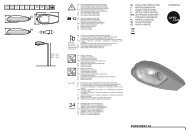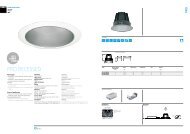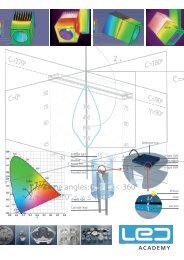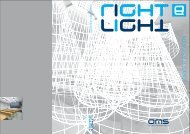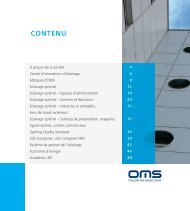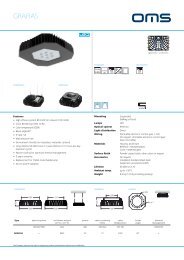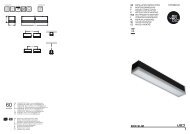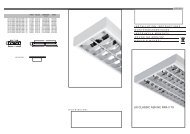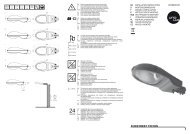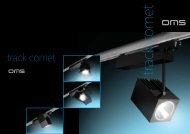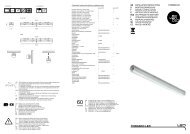Lighting MAnAgEMEnt SYStEM - OMS lighting
Lighting MAnAgEMEnt SYStEM - OMS lighting
Lighting MAnAgEMEnt SYStEM - OMS lighting
Create successful ePaper yourself
Turn your PDF publications into a flip-book with our unique Google optimized e-Paper software.
Types of control<br />
Manual<br />
Automatic<br />
Combined<br />
Constant illuminance sensor<br />
Daylight simulation<br />
PIR sensors can be utilised in both indoor<br />
and outdoor applications, be installed at<br />
various heights and work at different<br />
levels of sensitivity. the area that can be<br />
scanned depends on the height of installation<br />
and set sensitivity.<br />
The sensitivity of the sensor depends on<br />
various things. The ambient temperature of<br />
the space compared to the temperature of<br />
the person moving within the space, the direction<br />
of scanning and the extent to which<br />
the sensor is able to scan the movement.<br />
Maximum sensitivity in terms of movement<br />
detection is when the person passes<br />
through the ‘sight’ of the sensor at a right<br />
angle. When movement is parallel to the<br />
sight of the sensor sensitivity is decreased.<br />
In spaces where the scanning area is<br />
limited by various objects it is possible to<br />
use high-frequency movement sensors.<br />
High-frequency sensors are able to detect<br />
movement even through glass and thin<br />
walls, even the slightest movement, all<br />
independently of any changes in temperature.<br />
In order to achieve maximum coverage<br />
it is useful to overlap the scanning areas of<br />
individual sensors.<br />
For an ideal coverage of the space it is<br />
in general suitable for the scanning areas<br />
of the individual movement sensors to partially<br />
overlap each other.<br />
scanned angle<br />
sensor<br />
Depiction of the detection area<br />
non-scanned<br />
area<br />
radius of the<br />
scanned area<br />
scanned<br />
area<br />
height of sensor location<br />
sensor A<br />
minimal distance = X+Y<br />
X<br />
sensor B<br />
minimal<br />
vertical<br />
scanning<br />
area<br />
Y<br />
height of sensor location<br />
Suitable location of the movement sensors with<br />
partially overlapped scanning areas<br />
scanned<br />
area<br />
100%<br />
<strong>lighting</strong><br />
intensity<br />
10%<br />
movement<br />
0% time<br />
Time progress of the movement sensor—without delay<br />
100%<br />
<strong>lighting</strong><br />
intensity<br />
10%<br />
0% time<br />
Time progress of the movement sensor—with delay<br />
100%<br />
<strong>lighting</strong><br />
intensity<br />
movement<br />
movement<br />
delay time<br />
0% time<br />
Time progress of the movement sensor—with double delay<br />
100%<br />
<strong>lighting</strong><br />
intensity<br />
Incremental gradual<br />
increase (t=0s)<br />
Smooth gradual<br />
increase (t>0s)<br />
delay time<br />
delay time<br />
Incremental gradual<br />
decrease (t=0s)<br />
0% time<br />
100%<br />
<strong>lighting</strong><br />
intensity<br />
movement<br />
movement<br />
Smooth gradual<br />
decrease (t>0s)<br />
When we use motion detection based<br />
<strong>lighting</strong> control it is often apt to incorporate<br />
a delay in the dimming of the<br />
luminaires after the person has left the<br />
space. this means that the luminaires<br />
remain on for a defined time after presence<br />
is no longer detected.<br />
How long this delay will be depends very<br />
much of the type of space and the assumed<br />
frequency of movement or occupancy. The<br />
dimming can be set at a certain level, for<br />
example 10 % of the luminous flux, or even<br />
0 % where this is appropriate. A reduced<br />
luminous flux level approximately 10 % is<br />
used as a safety measure so that the space<br />
is not entirely dark, or that security cameras<br />
may still effectively operate, and also<br />
to prolong the lifespan of the light source.<br />
This functionality is often referred to as ‘the<br />
corridor function’. The system can also be<br />
set so that the <strong>lighting</strong> is reduced to 0 %<br />
after a subsequent delay.<br />
Once motion is again detected the luminaires<br />
switch on. The <strong>lighting</strong> level can<br />
be increased or decreased immediately or<br />
gradually, either smoothly or incrementally.<br />
The advantage of this graded change, possibly<br />
taking two seconds, is that the human<br />
eye is not strained by a sudden change in<br />
visual conditions, and also the light source<br />
lifespan is not shortened by extreme changes.<br />
This type of solution is ideally suited to<br />
spaces with a high frequency of occupancy<br />
and movement, for example in warehouses<br />
and corridors.<br />
0% time<br />
Scanning area of the passive infrared sensor (PIR)<br />
Scanning area of the high-frequency movement<br />
sensor<br />
Time progress of the movement sensor—with smooth regulation of luminous flux<br />
36 I TYPes of control<br />
TYPes of control I 37



